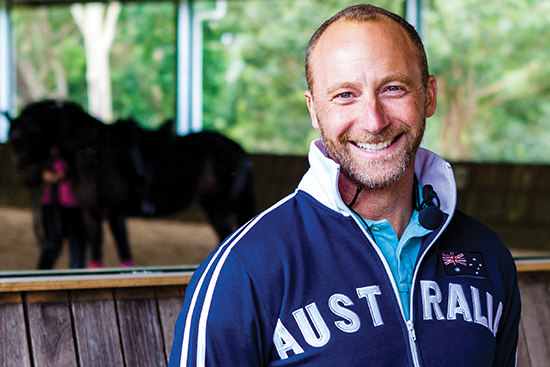 Story and photos by Rebecca Ashton
Story and photos by Rebecca Ashton
Okay you loved Jeremy’s explosive interview last month (you were not alone, the web story went ballistic internationally, and filled dressage forums the world over) – this month sit in and watch the man do what he does best…
Jeremy Steinberg can teach. That might sound like a given, seeing the well-respected American trainer has coached the US National Dressage Youth Team and the New Zealand High Performance Dressage Team. However, unlike many trainers, the American is very good at breaking down the work, explaining ideas, discussing training issues, and coming up with some very original analogies.
Here are some thoughts from a clinic at Heidi Scott’s lovely property just out of Sydney.
Position, position, position!
Jeremy knows the importance of position and it was the main focus in his lesson with young rider Mia Henderson.
“Riding is a bit like dancing…..posture! Everyday a little bit of no stirrups, ok? Chin up like I just pulled your ponytail back. Also watch your toes. They’re lazy.”
“Imagine you are at a rock concert. If you try to talk to someone at a rock concert, you have to scream at them. Make the environment (your position) like a library. This is why you have to sit quiet.”
“The rule of thumb for the hands is to have them about the width of the horse’s mouth. Sometimes you have to move them, but that’s where you’re aiming.”
Jeremy likes to produce a thinking rider. He does this by asking lots of questions and never giving away the answer. If a concept is not understood, he makes the rider walk and discusses it further. “What do I not like right now? Yes, your toes! Why am making you ride with no stirrups? (Answer: an independent seat) That’s right…and that’s rare these days.
“Are your abs and shins burning yet? Promise? You’re not just saying that?” enquired Jeremy with a smile.
A nice, loose swinging seat is a must and Mia was getting the hang of it. “Good! You’re sitting a lot deeper today. You should look like one unit with the horse, as if you’ve plugged your seat into the saddle like lego.”
Even walk at the loose rein isn’t a time for the rider to relax. “No dangly toes. Don’t let your leg hang there like noodles with no stirrups. What’s the most important angle in your body, the most important connection point in your body? Your hip. So, when you ride without stirrups, don’t drop your leg so much that the angle in your hip opens to the point that it hollows your lower back,” explained Jeremy.
Then it was back into the trot, “Does he feel like he’s going more forward or less forward? That’s right, he’s more forward. The better you sit, the more you may find he goes on his own a bit more.”
The trainer did a body scan of Mia the whole time: toes up, shins burning, engage the muscles between the shoulder blades, and then it was on to the hands. “Where do you feel the elasticity like you see with side reins?” After a few wrong answers: hands, horse’s mouth, reins, the right answer was reached: elbow.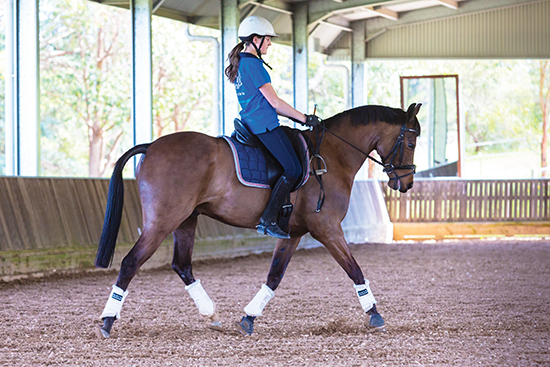
Mia Henderson, no stirrups
“What part of the horse’s body makes the contact heavier or lighter?” He wouldn’t give away the answer, Mia really had to guess. Jeremy backed up her answer, “His poll and jowl. How does he make it feel like his jaw softens? His poll. What’s a bad way he makes it feel like his jaw softens? Opens his mouth. That’s why we have a noseband so he learns to flex in the poll rather than open the mouth.”
“He has a neck like steel. It’s important to have a steadiness in your arm and hand so you hit that one little teeny area. You keep your arm and hand still. You can use your fingers and gently move the lower jaw because the jaw hinges up near the poll, but it’s small.”
“How much daylight should I see under your bum? None. That’s right.”
Jeremy then went on to explain why a supple, lengthened position is essential in dressage. “Leverage is the amount of force over a length you can apply to something. Have you changed a tire of a horse box? How long is the wrench that is used to remove the lug nut? Quite long, right? Over the longer length, it distributes the smaller force. The more leverage you have, the smaller your aids can be. The longer you are and the longer your legs, your centre of gravity is lower. Therefore, if you lean back an inch, that’s a lot of force. If you’re really short, you see little kids on ponies with their legs sticking out, they lean right back and nothing happens. So long legs are good, but not so long that the angle in your hip opens too much.”
Warmup and looseness
Lisa Just came into the arena cold, so Jeremy could take her through the warmup.
“For me, I wouldn’t have him as round as you had him in the warmup yesterday,” began Jeremy. “Don’t overthink all the things you want from him. Let him have a bit of a cruise for a minute. Don’t get too involved straight away and do too much. See where he goes if left to his own devices. Feel what his body is doing: neck, forehand, back, hindlegs. How are all the pieces coming to the work?”
“My horses are so thoroughly worked on an ongoing basis, that the warmup is me saying to them, here’s 10, 15, 20 minutes to just trot around and get the blood going. Give him his time, unless there is a problem, like he’s going to buck you off or spook. Otherwise, just this. Poll a little higher. Just wiggle on the bit a little if you feel him go against it. He’s got good rhythm and he looks really loose. The stride is swinging big through his body, which means the hindleg pulls on the back to get it to lift and loosen. Ask yourself, can I lengthen the stride or quicken the stride separately? If I can, do I lose anything else, does he learn against me or stiffen? Just test the waters. The swing is the pendulum, and that’s your ability to collect. That’s why the looseness is so important, to get the back up and this is where collection comes from.”
“The best warmup is the one that creates the best work. If I find it hard to get the horse up, it does me no good to ride it deep. If they are really rigid and have a jaw of steel, it does me no good to stretch him right out. It’s better just to let him potter around a bit and get him loose.”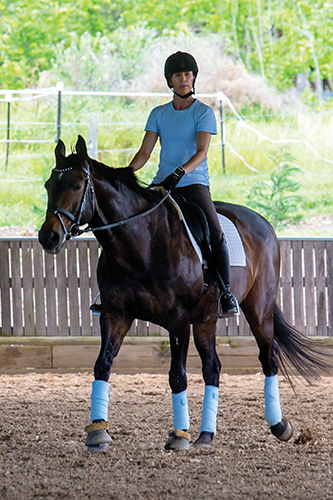
Lisa Just giving the horse a loose rein… important for muscle health
“Then, my first order of business is to get a normal, quiet, balanced easy to ride trot. Make it easy to manage, and easy to maintain. Then I start to ask what do I need: more softness, more rideability, more power and then I start to chip away at that. I have all these exercises and lateral movements to work on that. But my rules can’t change. If I add a bend, the speed can’t change or he can’t hang onto the contact.”
“Test if you can release one rein, and then the other, for a stride or two, and not have it fall apart or have the speed or balance change.”
Then Lisa gave her horse a break, but still asked for some roundness as the horse walked. Jeremy had a different idea, “I don’t get that, keeping them round when giving them a break in the walk. If there’s no problem, walk them on a long rein. It’s a confidence builder and it allows the tension to leave the muscles. If muscles are tired, ligaments and tendons take over the work because the muscle delays its response, the joint bends too far and you risk soft tissue injury. Have just enough contact. I walk a lot on a loose rein and all my Grand Prix horses, all of them, stay sound into their 20s. I had a hot Thoroughbred I couldn’t do that with and he had lots of tendon injuries. This is why I think this works.”
Taking it in Stages
Jeremy wanted the horses to understand what was expected of them in stages. There was no point going to the next level when the basics weren’t established.
He had the following advice for Lisa: “Get a baseline and add a little more. Don’t lose it. You have to put three layers of coat on a house. You don’t put the next layer on when the first one is wet or else it turns to goo. Cement your baseline, and when it’s right, then add. I have people come to me for a lesson, tearing around in counter canter. I say, how about we teach your horse to do a collected canter first, then they say no, I’m competing next weekend with that movement in it… Sorry, I can’t help you.”
“The pieces have to be in place or else the exercises are of no benefit. In fact, they can be detrimental.”
“When you brainwash someone, you get them to do something they don’t want to do. With your horse, you want to keep saying, “You’re carrying yourself, look, you’re carrying yourself” until he starts to answer back, “I’m carrying myself.” Does it feel like this is now the baseline? Yes. Good… now you can add more pressure. Don’t add too much at once or it becomes a wrestle. Dynamic growth in the trot should be subtle. Little bit at a time, not bang, all at once. It’s not supposed to be exciting, at the edge of your seat kind of stuff. It’s supposed to be a powerful dance, not wondering if one of the dancers is going to fall over!”
“You’ll never take him to a bad place if you stay calm, because then he’ll stay calm.
Power is developed from looseness, not tension. From trot, it’s from the swing, for canter it’s the jump.”
“I think it becomes so accepted to loosen the back by deepening the neck. Horses don’t function how we think, and we get a false feel. But this way they don’t give the poll but we feel the neck round so we think it’s ok. The weight is all on the front end. Sometimes you have to get them rounder or deeper; sometimes you have to do things to make them feel safe and get control, but then it’s back to the work. They need a round back in an uphill balance. The movement in their body cycles the looseness.”
“What’s classical dressage? Most people roll their eyes. It’s not about making the horse deep. It’s not about riding the horse above the bit either. But just getting the head down doesn’t mean getting the horse on the bit. Is there an argument about a classical way to sit? No. What’s the right posture and way to sit? It’s about sitting vertical. What’s the rule about elbow, hand and mouth? Why do we think it’s ok to change that to get the horse’s neck down? You can do it for a moment but you don’t want to live there. Always go back to the ideal.”
Collection and Strength Training
Claire Seidl was working with her young mare and Jeremy was enthusiastic with their progress. “She’s looser today and gives you that gentle drawing feeling in the mouth, that she wants to arch her neck and lift her back. You want that feeling that they gently pull and draw you up the long side. Then you can play with little, mild increases in pace, even on the circle. Get the top line to work like a giant accordion. Like in and out breathing. The body quietly moves through its spectrum, like a pendulum, in and out.”
“Then when you get into more collection, into the working stage of the session, the swing of the hindleg is still there; the powerful, pendulum swing of the hindleg. This drives the wither higher into the air. As you go on, you keep asking a little higher, a little shorter and keep the power, so supplement with a little push. For example, pretend at the moment you’re driving 40km on flat ground. Imagine as you collect the horse, it’s as if the car hits the hill, to maintain 40km/hr, you have to ask a little more to negate any slowing down.”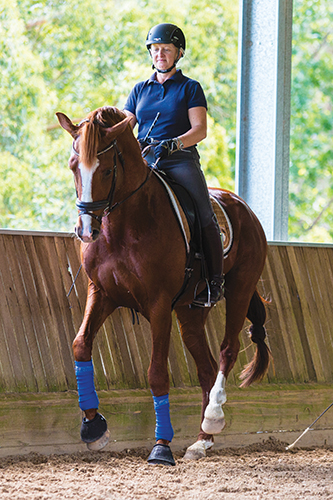
Claire Seidl and TS Wicked
“I want a small stride in terms of ground cover, but I want a big stride within that. I want a high stride. This is one of the key players…when the rhythm really stays intact, you know that the hindleg is ticking over. If she starts to slow, you know she’s just leaving the hindleg behind, crouching and getting lower to the ground.”
“You want to feel like you are owning some of the impulsion when you drive, and you have an influence on the front end lifting. If the front end just expands, it’s not bad, but it’s not impulsion. It’s like a power boat lifting up in front. If it flattens out, you’ve asked too much.”
Claire also brought her stallion along and Jeremy engaged them in similar work. “Just bring the circle in smaller and really feel that he canters it. This creates some real strength in the canter. You don’t need to add pirouettes or even haunches in yet.”
“Ride a small circle and then take it out, but don’t let it out too much. Everything that’s thinking, height of the shoulder, height of the front leg, tucking of the hindleg. Lower the croup and bend the hip, stifle and hock. Collection isn’t about making the stride little, but by you taking the weight on the hindleg and making the stride big, but not covering lots of ground. This strength training makes the collection strong down the track, so later they don’t take a small step and start crouching.”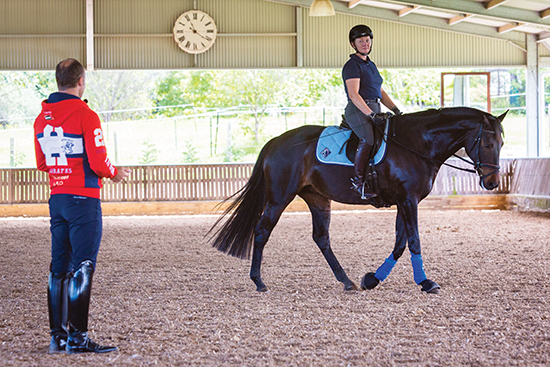
Jeremy with Claire and TS Dubai
And it was the same story when it came to transitions between paces, “In the canter to walk transition, don’t make it a smaller, smaller, smaller canter. It’s more about jump under, under and under, or else he’ll think why sit when I can just keep my hocks stiff, crouch and drop my belly? Then they never learn to get it out of the hindleg. This might take six months to a year. It probably won’t, but give yourself the time.”
“You need little, bouncing half halts to say stay up, and little quick tickles with the leg to say stay tucked under. The energy of the hindleg goes into the hand, but the hand guides and catches if he falls out of balance, but it’s not holding or blocking the energy. Don’t fix the back with the neck, fix it with the hindleg. Ride his hindlegs to create the right frame, the right balance. Shape the topline from behind.”
There was a small mistake to trot from canter, but Jeremy didn’t want the rider to help out too much, “Say to the horse, I’m going to help you fix the problem, but not clean up your messes because then you can sometimes create a new problem. You don’t want to ruin the good that you’ve created.”
Personal Trainer and Mental Coach
Corinne Watkins was on an older mare, but Jeremy didn’t see that as a reason to back off. Even the slightly older horses can learn new things. “We’re going to do 50 ab crunches today (half halts). It might be in a half pass or a shoulder in. We’re the educators of the young horses then, the education hour is over and it’s our job as riders to act as a personal trainer. We want big, strong muscles in the back, neck and top line. She might grunt and swear about how hard it is, but don’t take it personally and don’t take offence. But everyday she works and get stronger, the complaining will get less.”
“Horses get strong fast. Humans don’t. Horses are a flight animal and we are a predator. We get fed and looked after, but it isn’t so much like this with a flight animal. They have to learn to run and keep up. Therefore horses get fit fast, learn balance fast, and can adapt fast. So, they get strong fast. One or two weeks of intense work and they can feel like a different horse.
“You always want to look at strengthening the weak point and loosening the tight point. They come up with so many different ways of compensating. When they don’t want to bend, they like to lean to the inside hindleg. They must not learn something the wrong way, because then it’s ten times harder to teach it out of them again.”
“If you take a horse and teach it really good pirouettes, then don’t ask for it for a while, at 17 years old, ask for it…boom, it’s there. You could put grandma on and the horse can start piaffing. The horse has learnt to recycle the energy so well in its past training.”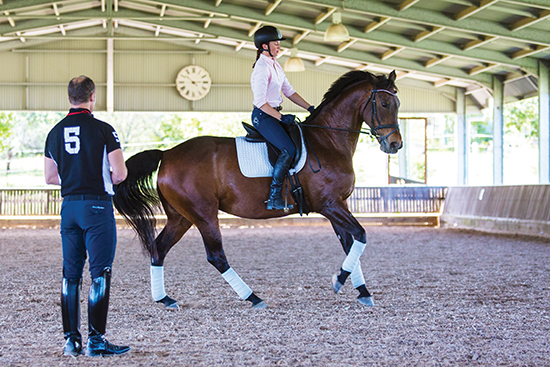
Jeremy with Corinne Watkins and Flowervale Floranthe
Corinne was a little concerned with her horse clunking its teeth and Jeremy explained, “You have to get a horse strong mentally as well as physically. I’m more worried about the mental state. For that you just keep repeating so they know they never get in trouble. If my horses grind their teeth, there’s something going on in there; something isn’t balanced. But with your horse, what can you do? Tighten the noseband? But this will just make it worse. You have to be careful you don’t over pressure them, but you still have to train them, and go to those places. Some of them get more worried about things than others, and that can be their personality too.”
The higher the horse went in the frame and the better the connection, the quieter it got in the mouth. “When they get too curled up, that can have an influence too,” continued Jeremy.
Jeremy was clear about the responsibility riders have and the discipline needed to train horses correctly and fairly, one step at a time. Rider position needs to be correct and horses need to be introduced to ideas in stages. He approached each lesson with clear, philosophical analysis and most importantly….fun.
This article first appeared in the March 2016 issue of THM.



i love this
this is such a good artcal